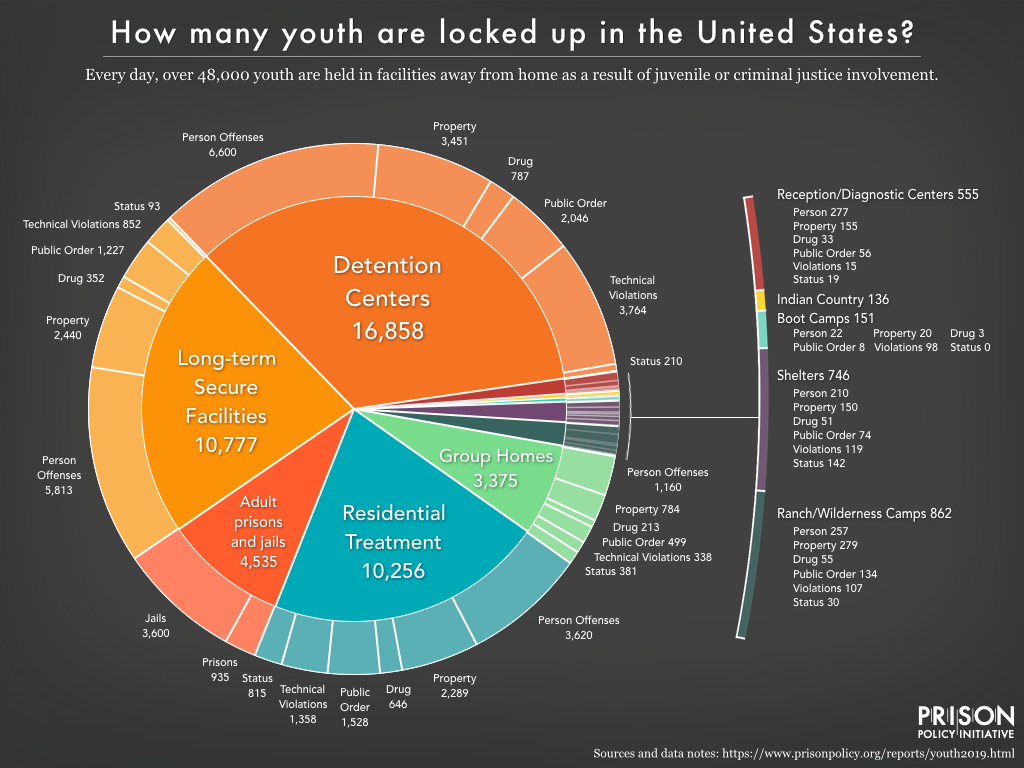|
States could release nearly 30 percent of the young people currently held in juvenile facilities across the U.S. without endangering public safety, says the Prison Policy Initiative (PPI).
The recommendation was one of several drawn from a report illustrating the “failures” in the juvenile justice system that “mirror failures in the adult system.” According to the report, 48,000 youths under the age of 18 were held in some version of confinement in 2019—a 60 percent drop since 2000. But while the declining population of incarcerated youth was a welcome trend, it left unaddressed the serious racial disparities, draconian discipline and unhealthy conditions that characterize the experience of those who still remain behind bars, according to Wendy Sawyer, Research Director of the PPI and the report’s author. “Two out of every three confined youth are held in the most restrictive facilities — in the juvenile justice system’s versions of jails and prisons, or in actual adult jails and prisons,” wrote Sawyer. And some 92 percent of confined youths are in locked facilities where they are subject to restraints like strait jackets or prolonged periods of solitary confinement—even though the nature of their offenses suggests they shouldn’t be confined at all, said the PPI. “By our most conservative estimates, states could release at least 13,500 more youth today without great risk to public safety,” according to the study, entitled “Youth Confinement: The Whole Pie 2019.” That number would include nearly 1,700 youth held for status offenses; 1,800 held for drug offenses other than trafficking; over 3,300 held for public order offenses not involving weapons; and 6,700 held for technical violations. “States should also look more closely at youth detained pretrial,” Sawyer recommended. “Beyond youth detained for those low-level offense categories, over 7,000 others are held before they’ve been found guilty or delinquent. “Many, if not all, of these youth would be better served in the community.” The falling population of confined youth has also exposed stark racial disparities, in which African-American and Native-American youth are over-represented. Some 42 percent of boys and 35 percent of girls in juvenile facilities are African-American, though only 14 percent of all U.S. youth under 18 are black. One of the most glaring contrasts found by the researchers was in the number of Native- American girls confined. Although Native Americans represent less than 1 percent of all U.S. youth, 3 percent of the girls detained—not including those held in tribal facilities—are Native American. The report also examined the types of facilities where young people are held around the country, noting that these can “affect their health, safety, access to services, and outcomes upon reentry.” Adult prisons and jails are regarded as the worst places, but even for those in juvenile detention facilities the conditions offer little hope for rehabilitation or treatment of problems relating to mental health or substance abuse. The report also noted that pretrial detention is “surprisingly common.” Over a quarter of delinquency cases commit young people behind bars who have not been sentenced, the PPI said. According to the PPI, the movements to reverse adult mass incarceration and to “de-institutionalize” justice-involved youth have remained “curiously distinct.” “But the two systems have more problems—and potentially, more solutions—in common than one might think,” Sawyer wrote. “The momentum of decarceration in the juvenile justice system must continue, and it should inspire bolder reforms in the criminal justice system as well.” To see the full report, please click here.
0 Comments
Leave a Reply. |
HISTORY
April 2024
Categories |
© Walk 4 Change. All rights reserved.


 RSS Feed
RSS Feed